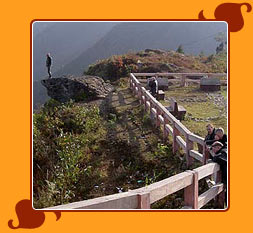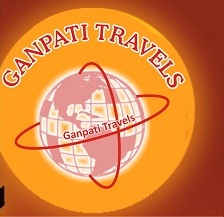Kalimpong is a bustling and rapidly expanding,
though still relatively small, bazaar town set among the rolling foothills
and deep valleys of the Himalayan at an altitude of 1250m. It was once part
of the lands belonging to the rajas of Sikkim, until the beginning of the
18th century when it was taken from them by the Bhutanese. In the 19th
century it passed into the hands of the British and thus became part of West
Bengal.

It became a centre for Scottish missionary activity in the late 19th
century, and Dr Graham's orphanage and school is still running today.
Kalimpong's attractions include three monasteries, a couple of solidly built
churches, an excellent private library for the study of Tibetan and
Himalayan language and culture, a sericulture, orchid nurseries and fine
views over the surrounding countryside.
Although not many
travelers bother to visit Kalimpong, there's enough here to keep you
occupied for a couple of days, and for the energetic there's some good
trekking. The most interesting part of a trip to Kalimpong is the journey
there from Darjeeling via the Teesta River bridge. If you have no permit for
Sikkim then the town is worth visiting just for the journey.
SightseeingGompas:Established in 1922, the Tharpa
Choling Gompa belongs to the Yellow Hat Sect of Tibetan Buddhism, founded in
the Tibet in the 14th century and to which the Dalai Lama belongs. It's a 40
minute walk from town; take the path to the right off KD Pradhan Rd, just
before the Milk Collection and Extension Wing Building.
Lower down
the hill, the Thongsa Gompa, of Bhutanese Monastery, is the oldest monastery
in the area and was founded in 1692. The present building is not so old -
the original was destroyed by the Gurkhas in their rampage across Sikkim
before the arrival of the British. Zong Dog Palri Fo-Brang Gompa, five km
south of the town centre at the end of the ridge, was built in the mid -
1970s at Durpin Dara Hill and was consecrated by the Dalai Lama. There are
impressive wall paintings in the prayer room, and a rare three dimensional
mandala upstairs. Mountain views are good from Durpin Dara Hill. This area
is a big military camp, but you are free to walk or drive through it.
Flower
Nurseries:Kalimpong produces 80% of India's gladiolas and is an
important orchid - growing area; flowers are exported from here to many
cities in northern India. The Sri Ganesh Moni Pradhan Nursery and the Udai
Mani Pradhan Nursery are among the most important in the area. The Standard
and the Universal Nurseries also specialise in cacti. There's a flower
festival in Kalimpong in October.
Dr Graham's Home:It
takes less than an hour to walk from the town centre up through stands of
bamboo to Dr Graham's Home, which was founded in 1900 on the lower slopes of
Deole Hill. The school was established to educate the children of tea
workers.
There are now 1300 students and the grounds cover 193
hectares. Enrolment is open to all, but there is a reserve quota for
children from economically deprived backgrounds. Visitors are welcome to the
turn-of-the-century school buildings, and many people picnic in the
attractive grounds. From the school itself, it is a 40 minute walk to the
summit of Deole Hill, where there are fine views over Kalimpong.
ShoppingOpen
Wednesday and Saturday, the market is definitely worth visiting, especially
if you want to meet the locals. The most interesting shopping is that of
fresh local produce. Ginger, honey, a special kind of strongish cheese,
Tibetan noodles. The Bhutia Shop, Dambar Chowk, stocks traditional Bhutia
crafts such as woodcarvings, as well as pastel paintings, embroidered bags
and other items.
Kalimpong tapestry bags and purses, copperware,
scrolls and paintings from Dr Graham's Home are sold at the Kalimpong Arts &
Crafts Co-operative. Shops selling Tibetan jewellery and artifacts can be
found in the streets to the east of Dambar Chowk.






 It became a centre for Scottish missionary activity in the late 19th
century, and Dr Graham's orphanage and school is still running today.
Kalimpong's attractions include three monasteries, a couple of solidly built
churches, an excellent private library for the study of Tibetan and
Himalayan language and culture, a sericulture, orchid nurseries and fine
views over the surrounding countryside.
It became a centre for Scottish missionary activity in the late 19th
century, and Dr Graham's orphanage and school is still running today.
Kalimpong's attractions include three monasteries, a couple of solidly built
churches, an excellent private library for the study of Tibetan and
Himalayan language and culture, a sericulture, orchid nurseries and fine
views over the surrounding countryside.